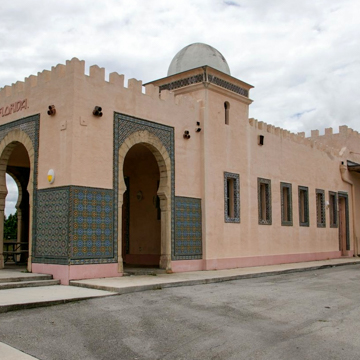The Moorish Revival forms of Opa-locka’s major civic structures help foster the Arabian Nights theme chosen by the city’s founder, Glenn Curtiss, in 1925. The Opa-locka Railway Station was designed by Bernhardt Emil Muller, the architect selected by Curtiss to realize his vision of a city whose picturesque buildings and subtropical climate would lure homebuyers and business owners intrigued by the exotic tales of The Thousand and One Nights. Unlike Coral Gables, the Mediterranean Revival real estate development launched by George Merrick and which inspired Curtiss’s venture, Opa-locka boasted a centrally located railway station that connected the business district with Miami. For visitors to Opa-locka, the Arabian fantasy would begin the moment they disembarked the train.
The railway station marked the Opa-locka stop on the Seaboard Air Line Railroad, which was known for the architectural flair used in many of its stations, most notably the West Palm Beach depot designed by local firm Harvey and Clarke in a Spanish Colonial Baroque style. Incorporated in 1900, the railroad combined a number of existing Mid-Atlantic and Southeastern rail lines, and expanded into South Florida during the land boom of the 1920s. The railroad reached as far north as Richmond, Virginia, and as far west as Birmingham, Alabama, and ended in Homestead, south of Miami.
The Opa-locka Railway Station displays a broad range of forms and decorative motifs drawn from architecture in North Africa and the Middle East. Horseshoe arches and other openings are surrounded by vibrantly colored and geometrically patterned ceramic tile; crenelated parapets punctuate the skyline; and a pair of corner towers exist seemingly to provide a platform for slightly elongated domes. The building’s rough stucco walls and wood canopies extend the illusion of great age, preparing the visitor for the architectural fantasy planned for the rest of the city.
Muller exhibited a strong aptitude for assimilating the details of Moorish Revival architecture. Trained at the Ecole des Beaux-Arts in Paris (1903–1905) and leavened by studious travel in Italy, France, Austria, and Germany, Muller was well-versed in the language of Neoclassicism. He opened his own atelier in New York in 1914 after working for several firms there during the previous eight years. By 1923, Muller was designing houses around Miami, quickly adapting to his clients’ Mediterranean Revival tastes.
Muller designed over eighty buildings in Opa-locka, including at least sixty houses. Twenty surviving structures are listed on the National Register of Historic Places and are included in the Opa-locka Thematic Resource Area. City Hall, the former Opa-locka Company Administration Building, is the most prominent building in the city by virtue of its size, location, and elaborate decoration. The other buildings realized by Muller include the railway station, two office buildings, a block of stores, an apartment building, thirteen houses, and an Egyptian Revival bank. Across Ali Baba Avenue from the train station, the Harry Hurt Building, a two-story structure with domes and minarets, marks the intersection of Sharazad Boulevard, the city’s principal axis.
Several of Muller’s buildings were demolished, among which the Observation Tower represents perhaps the greatest loss. The four-story tower had battered walls wrapped by a wooden stair and capped by a pointed dome. Seemingly a picturesque folly, the tower served the important function of allowing prospective buyers to look out over the existing canopy of trees in order to get a sense of the emerging town. The structure was demolished during World War II, when the Navy expanded the adjacent base. Of the numerous unrealized projects envisioned by Muller, the most fantastic is likely the automobile service station, where a pair of freestanding minarets flanking the gas pumps framed the view of asymmetrical building featuring exterior stairs, roof terraces, a balcony, and a trellis, all culminating in a large dome capped by a crescent moon.
In 1996, the Opa-locka Tri-Rail Station opened adjacent to the 1927 rail station. It has served the city’s commuter population ever since.
References
FitzGerald-Bush, Frank S. A Dream of Araby: Glenn H. Curtiss and the Founding of Opa-locka.Opa-locka, FL: South Florida Archaeological Museum, 1976.
Lynn, Catherine. “Dream and Substance: Araby and the Planning of Opa-Locka.” The Journal of Decorative and Propaganda Arts23, Florida Theme Issue (1998): 162-189.




















